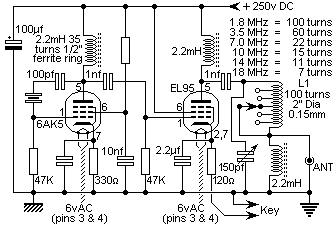

This transmitter is very stable and will deliver up to seven watts of power. Do not be put-off by valves as they are VERY easy to work with and it seems that there are quite a few valves around. Because no-one wants these obsolete things they may be bought for next to nothing at radio rally's. If you are not too particular what type of valve you want then there are lots of valves available. Above is the circuit of the transmitter with the coil winding information. The oscillatoar is a Pierce oscillator circuit which will oscillate at the fundamental frequency of the crystal. A 25pf variable capacitor between the grid of the first valve and earth will allow the final frequency to be "pulled" a little. The RF choke in the anode of the two valves is made up of 34 turns of enamelled wire wound on a 1/2" ferrite ring (2.2mH). The output tank circuit is wound on a piece of 2" dia plastic conduit tube. The object is to have as many turns of wire in circuit as it is possible to have on the band of interest. The output tuning capacitor should normally be set to about 10% when selecting the tapping for any particular band. The cathode resistor and 2.2uf capacitor give quite a nice envelope to the keyed output. When the key is UP (off) there is about 100 volts DC across the 2.2uf so this component must be rated in excess of 100v. I obtained mine from an old telephone as telephones nearly always have a 2.2uf 250v non-electrolytic capacitor somewhere in the circuit. The oscillator is un-tuned so the only tuning procedure required is to select the band (coil tapping) and peak it for maximum RF output. The valves used were selected because they had B7G bases and were the first I put my hand on when I reached into my junk-box. Virtually any pentode valves will work in this application. An EL84, for example, will deliver over ten watts in this circuit but the valves quoted will deliver seven watts from 3.5 to 30 MHz. If you should use another tube then don't forget to check the screen voltage. If it is less than 250v then you will need a resistor in the screen supply to the valve. Have fun, de HARRY, Upplands Vasby, Sweden
I am very grateful to Harold, SM0VPO for allowing me to add his files to my web site. He can be contacted by email: harold.lythall@era.ericsson.se
Frank, G3YCC